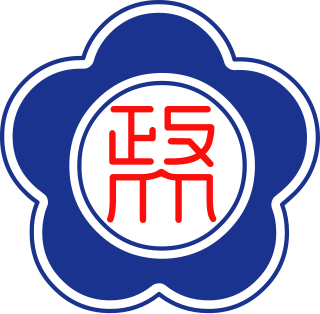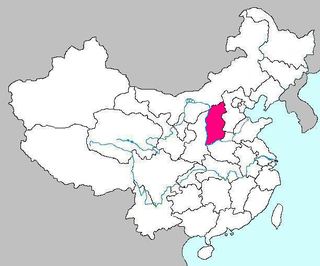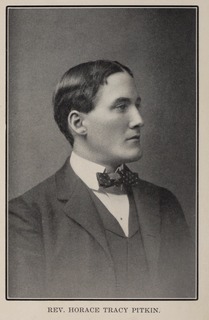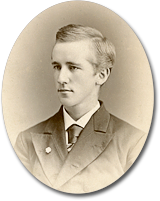History
In 1881 students at the Oberlin Graduate School of Theology decided to form into a group, “The Oberlin Band,” to do mission work in China's then remote Shansi Province (now romanized as “Shanxi”) under the American Board of Commissioners for Foreign Missions (ABCFM). [2] In 1900 thirteen of them and many Chinese Christians were killed in the Taiyuan Massacre during the Boxer Uprising. [3] In the aftermath, a well connected young Christian, H.H. Kung helped administer the Boxer Indemnity funds and secured a piece of land for the use of the mission. In Oberlin, the ABCFM erected a Memorial Arch with the inscription, “The Blood of the Martyrs is the Seed of the Church.” [4]
After Kung earned degrees at Oberlin College and Yale University, he returned to his native Taigu in 1909 and established a set of schools, the Ming Hsien (for boys) and Beilu (for girls), which constituted “Oberlin-in-China.” In 1920s Ming Hsien became co-educational, the first school in Shanxi to do so. A village reconstruction center devoted to literacy education, public health and agricultural improvement, was established nearby. In 1937, Ming Hsien, to avoid the Japanese invasion, moved to a site just outside Chengdu in Sichuan, returning to Taigu in 1949. After the outbreak of the Korean War in 1951, the school was closed and the building made the basis of the Shanxi Agricultural University. Formal relations with Oberlin were not renewed until 1980. [5]
In the following years, Oberlin Shansi created new exchange relationships with Tunghai University in Taiwan, a relation which lasted until 1978; with The American college in Madurai, Lady Doak College in Madurai, south India; and other institutions in Indonesia and Korea; and Oberlin University in Tokyo. [6]
Although in the early period the tone was distinctly Christian and the goal was Christian service, the Association focused on educational and cultural work, and was never a religious mission. As the prospect of returning to China emerged in the 1970s, mention of Christianity was removed from the Regulations. The early work was financially supported from gifts and student fees, but much of the endowment was given by the estate of Charles Martin Hall, an Oberlin graduate and founder of Alcoa. [7]
Observers have noted the “Oberlin spirit” – ideals of academic excellence, service, and international peace and friendship – which gave the enterprise a missionary tone and sometimes ethnocentrism (particularly in the Association's early years). [8]
A number Shansi Reps and Fellows went on to influential careers, particularly in Asian Studies. In 2012, Carl Jacobson, who served as executive director from 1982, was succeeded by Gavin Tritt.

Kung Hsiang-hsi, often known as Dr. H. H. Kung, was a Chinese banker and politician in the early 20th century. He married Soong Ai-ling, the eldest of the three Soong sisters; the other two married President Sun Yat-sen and the latter President Chiang Kai-shek. Together with his brother-in-law, Soong Tse-ven, he was highly influential in determining the economic policies of the Kuomintang-led Nationalist government of the Republic of China in the 1930s and 1940s.

National Tsing Hua University is a public research university in Hsinchu City, Taiwan.

The American Board of Commissioners for Foreign Missions (ABCFM) was among the first American Christian missionary organizations. It was created in 1810 by recent graduates of Williams College. In the 19th century it was the largest and most important of American missionary organizations and consisted of participants from Protestant Reformed traditions such as Presbyterians, Congregationalists, and German Reformed churches.

Shanxi University is a public university located in the city of Taiyuan, Shanxi province, China.

Shanxi Agricultural University (山西农业大学) is a university in Shanxi, China under the authority of the provincial government.

National Chengchi University is a public research university in Taipei. The university is also considered as the earliest public service training facility of the Republic of China. First established in Nanjing in 1927, the university was subsequently relocated to Taipei in 1954. It is considered to be one of the most prestigious and prominent universities in Taiwan. The university, abbreviated as NCCU, specializes in arts and humanities, mass media, linguistics and literature, social sciences, economics, management, politics, and international affairs programs. It is the only publicly funded university in Taiwan which provides courses in journalism, advertising, radio and television, diplomacy, and several languages which are not taught at other institutions in Taiwan. The name Chengchi means governance or politics, and refers to its founding in 1927 as a training institution for senior civil service for the Nanjing Nationalist government of the Republic of China. The university has strong ties with academic institutions like Academia Sinica, National Yang Ming Chiao Tung University, National Taiwan University and National Palace Museum. NCCU is a member of the University System of Taiwan.

Tunghai University is the oldest private university in Taiwan, established in 1955. It was founded by the United Board for Christian Higher Education in Asia (UBCHEA). It is located in Xitun District, Taichung, Taiwan. According to Times Higher Education's Impact Rankings 2020, the university is rated as the most impactful private university in Taiwan and third in the country.
Shanxi merchants, also known as Jin merchants, were the group of merchants from Shanxi province, China. Jin is an abbreviated name of Shanxi. Even though the history of noticeable Shanxi merchants can be dated back to as early as the Spring and Autumn Period, more than 2000 years ago, Shanxi merchants became prominent during the Ming and Qing dynasties, and their dominant influence in Chinese commerce, within the nation and with neighboring Mongolia, Russia, and Japan, lasted for more than 500 years.
Articles related to Taiwan include:
The Taiyuan massacre took place during the Boxer Rebellion, July 9, 1900, in Taiyuan, Shanxi province, North China. Reports at the time alleged that Yuxian, governor of Shanxi, ordered the killings of 45 Christian missionaries and village Christians, including children.

William Scott Ament was a missionary to China for the American Board of Commissioners for Foreign Missions (ABCFM) from 1877, and was known as the "Father of Christian Endeavor in China." Ament became prominent as a result of his activism during the Boxer Uprising and controversial in its aftermath because of the personal attacks on him by American writer Mark Twain for his collection of punitive indemnities from northern Chinese villages.

Taigu is a district of Shanxi province, China under the administration of Jinzhong City. It is administratively into three town-level entities, and six township-level entities. Taigu is linked to nearby Yuci in Jinzhong by rail via the Taigu Railway Stop.

The Northern Chinese Famine of 1876–1879 was led by drought-induced crop failures began in 1875. Between 9.5 and 13 million people in China died, mostly in Shanxi province, but also in Zhili, Henan and Shandong. The population reduction in censuses, which include famine migration, shows a drop of 23 million people, among which Shanxi lost 48%, Shaanxi lost 25%, Henan lost 22%. The drought was influenced by the El Niño-Southern Oscillation.

The Oberlin Band was a group of Christian missionaries in China from Oberlin College in Ohio. Members of the Oberlin Band worked in Shanxi province from 1882 until 1900. During the Boxer Rebellion in 1900, the 15 missionary men, women, and children of the Oberlin Band were among the foreign missionaries executed by order of the provincial government or killed by Boxers and soldiers.

Horace Tracy Pitkin (1869–1900) was a missionary of the American Board of Commissioners for Foreign Missions who was killed in China during the Boxer Uprising in 1900. Yale China Mission,, was founded in his memory.

Charles Daniel Tenney was an American educator and diplomat to China. He was the first President of Peiyang University in Tientsin (Tianjin), China from 1895 through 1906 and acted as Secretary of the Tientsin Provisional Government from 1900 to 1902. After ending his service to the Chinese Government, Tenney served as Secretary to the American Legations in Peking (Beijing) and Nanking (Nanjing).

Anthony Eugene Clark is an American Sinologist, historian, and writer who has authored dozens of books, articles, and other publications in the fields of Sino-Western, Sino-Missionary, and ancient Chinese history. He is the Edward B. Lindaman Endowed Chair and a professor of Chinese history at Whitworth University. He previously taught courses on Chinese history, culture, and literature at the University of Oregon and The University of Alabama. His most widely read books are China's Saints: Catholic Martyrdom during the Qing, Heaven in Conflict: Franciscans and the Boxer Uprising in Shanxi, and China Gothic: The Bishop of Beijing and His Cathedral, which includes a foreword by the architectural historian, Leland M. Roth. Clark's major interest is late-imperial China, especially the final decades of the Qing Dynasty, and the intellectual and religious relations between China and the West.
Shanxi architecture, or Shansi architecture, or Jin architecture, refers to the architectural style of the Shanxi province in northern China. Shanxi has preserved numerous ancient architectures scattered throughout the province. All of the four remaining wooden structures preserved from Tang dynasty in China are found in Shanxi. The old buildings of Pingyao ancient city and numerous family compounds of Shanxi merchants in the Ming and Qing dynasties are representative of the architecture styles of vernacular architecture in North China. Religious temples in Mount Wutai and Yungang Grottoes in Datong exemplify the sacred buddhist architecture in China.

Sarah Luella Miner was an American educator and Christian missionary in China. She founded and led the North China Union College for Women, China's first women's college.















